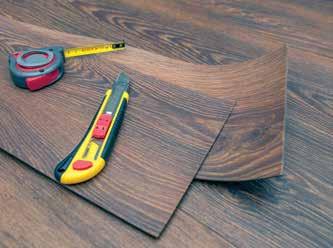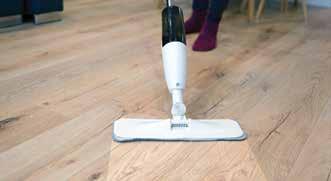
3 minute read
Installation and Maintenance
Getting Ready to Install
Why leave the installation of your beautiful new resilient floor to just anyone? For a floor that has a 15-year warranty, you want that installation to be perfect. Otherwise, you’ll be living with someone else’s mistakes every day for those 15 long years. Professional installation makes sense.
Advertisement
The key to a flawless installation is an experienced crew with specific knowledge of the material and expert in its placement. As you’ve seen through this book, the resilient flooring category has expanded to include luxury vinyl tiles, laser-cut linoleum inserts, and sustainable materials like leather and cork. Each resilient subcategory has installation requirements that the installer must fulfill to meet the manufacturers’ comprehensive warranties and guarantees.
When you buy your flooring, your retailer may offer installation services in-house or have recommendations for the local professional with the skills your flooring requires. If you choose to work with your retailer on the installation, a sales or design associate will schedule delivery and the installation. This takes a burden off your shoulders and ensures a good experience.
Even as affordable as resilient flooring is, it’s an investment in your home, both financially and aesthetically. Using the retailer’s installation service may cost you a bit extra, but it is offset by the assurance that there will be someone on the end of the phone should a problem arise

Installers standing by their work
When selecting an installer, ask if they warranty their work and for how long. Responsible installation services stand by their work for at least a year, some for the life of the flooring. Make sure that the warranty terms are included in the estimate for installing. And ask for and check references.
If you are pricing out installers, the estimate should include all related costs beyond labor, including adhesives, membranes or underlayment, sub-flooring repair, and any pre-installation work like moving furniture or removing old flooring.
First Things First
The flooring is ordered; you know it’s going to look great! Finally, the date for installation is set. This means it is time to get busy preparing your space for the new floor.
First things first. Plan to remove all the furniture, floor fixtures, furnishings, window treatments, and appliances from the room. If the window treatments are permanent, cover them with a dust cloth; if they reach the floor, pin them up first. Remember to schedule a professional to disconnect and reconnect propane or natural gas appliances.
Unless the resilient is being installed over the existing floor, that flooring must be removed and disposed of. If there are any surprises when you take up the old floor as another layer of flooring, let your flooring installer know to find out if that flooring needs to go too.*
Another surprise that can pop up at this stage is the newly exposed sub-floor is in bad shape. Again, call the installer because they may need to attend to a repair ahead of time. If it looks good, be sure to remove all tacks, adhesive and give a vacuum, then damp mop.*

Planning and scheduling
Onceyou have the date, arrange to be onsite for the installation. This way, if there are any last-minute changes or questions, you will be able to address them immediately.
Next, arrange for children and pets to be away from the installation area and the parked work vehicles. There are all kinds of temptations for a child or pet to get into on the job site. And, cats like to make themselves at home in open work vehicles.
If you live in a gated community or secure building, arrange for the work crew to have passes and parking for their vehicles. Also, secure access to a service elevator if needed. ■
*Your flooring retailer or installer can help you with these tasks. Contact them beforehand so the installation can proceed, and your beautiful, resilient floor will be in place!











